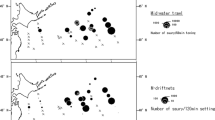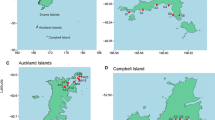Abstract
Drifting seaweeds play important ecological roles in offshore waters. Recently, large amounts of drifting seaweed rafts were found in the eastern East China Sea between the continental shelf and the oceanic front of the Kuroshio Current. However, so far there have been no quantitative reports about this particular area. Two research cruises were organized to survey abundance and standing crop of drifting seaweeds in eastern East China Sea in May 2002 and March 2004, using visual census and net sampling of drifting seaweeds. Visual census data were composed of drifting seaweed raft diameter, perpendicular distance from the transect (navigation course of the research vessel) to the raft, and positions. Using these data, we calculated the “effective stripe width” using the DISTANCE software. Drifting seaweed abundance (composed exclusively of Sargassum horneri) in waters located between the continental shelf peripheral area and the Kuroshio oceanic front was estimated to be higher than in any other area within eastern East China Sea in March and May. Abundance means in May 2002 and March 2004 were 6.14 and 29.05 rafts km−2, respectively, while standing crop reached 126.81 and 20.35 kg km−2 (wet weight). Mean diameter and drifting seaweed rafts in May 2002 were significantly greater than in March 2004, reflecting seasonal growth of Sargassum horneri.






Similar content being viewed by others
Abbreviations
- AIC:
-
Akaike’s Information Criterion
- ESW:
-
Effective Strip half-Width
References
11th Regional Coast Guard Headquarters (2002) Oceanographic Rapid Report, No. 10, 1–2
11th Regional Coast Guard Headquarters (2004) Oceanographic Rapid Report, No. 5, 1–2
Buckland ST, Anderson DR, Burnham KP, Laake JL, Borchers DL, Thomas L (2001) Introduction to distance sampling - estimating abundance of biological populations. Oxford University Press, New York, 432pp
Cho SH, Myoung JG, Kim JM (2001) Fish fauna associated with drifting seaweed in the coastal area of Tongyeong, Korea. Trans Am Fish Soc 130:1190–1202
Hernández-Carmona G, Hughes B, Graham MH (2006) Reproductive longevity of drifting kelp Macrocystis pyrifera (Phaeophyceae) in Monterey Bay, USA. J Phycol 42:1199–1207
Hobday AJ (2000) Abundance and dispersal of drifting kelp Macrocystis pyrifera rafts in the Southern California Bight. Mar Ecol Prog Ser 195:101–116
Ichimaru T, Mizuta K, Nakazono A (2006) Studies on the egg morpgology and spawning season in the mirror-finned flying fish Hirundichthys oxycephalus in the waters near Kyushu, Japan. Nippon Suisan Gakkaishi 72:21–26. (in Japanese with English abstract and figure legends)
Ingólfsson A (1995) Floating clumps of seaweed around Iceland: natural microcosms and a means of dispersal for shore fauna. Mar Biol 122:13–21
Kingsford MJ (1992) Drift algae and small fish in coastal waters of northeastern New Zealand. Mar Ecol Prog Ser 80:41–55
Kingsford MJ (1995) Drift algae: a contribution to near-shore habitat complexity in the pelagic environment and an attractant for fish. Mar Ecol Prog Ser 116:297–301
Komatsu T (1985) Temporal fluctuations of water temperature in a Sargassum forest. J Oceanogr Soc Jpn 41:235–243
Komatsu T (1989) Day-night reversion in the horizontal distributions of dissolved oxygen content and pH in a Sargassum forest. J Oceanogr Soc Jpn 45:106–115
Komatsu T (1997) Long-term changes in the Zostera bed area in the Seto Inland Sea (Japan), especially along the coast of the Okayama Prefecture. Oceanol Acta 20:209–216
Komatsu T, Kawai H (1986) Diurnal changes of pH distributions and the cascading of shore water in a Sargassum forest. J Oceanogr Soc Jpn 42:447–458
Komatsu T, Murakami S (1994) Influence of a Sargassum forest on the spatial distribution of water flow Fish Oceanogr 3:256–266
Komatsu T, Ariyama H, Nakahara H, Sakamoto W (1982) Spatial and temporal distributions of water temperature in a Sargassum forest. J Oceanogr Soc Jpn 38:63–72
Komatsu T, Kawai H, Sakamoto W (1990) Influence of Sargassum forests on marine environment. Bull Coast Oceanogr 27:115–126, 1990. (in Japanese with English abstract)
Komatsu T, Murakami S, Kawai H (1994) Some features of jump of water temperature in a Sargassum forest. J Oceanogr 52:109–124
Komatsu T, Tatsukawa K, Wang W, Liu H, Ajisaka T, Zhang S, Tanaka K, Zhou M, Uwai S, Sugimoto T (2005) Species composition and biomass of Sargassum beds in Gouqi Island, Zhejiang Province, China. Jpn J Phycol 53(1):103 (in Japanese)
Komatsu T, Tatsukawa K, Filippi JB, Sagawa T, Matsunaga D, Mikami A, Ishida K, Ajisaka T, Tanaka K, Aoki M, Wang WD, Liu HF, Zhang SD, Zhou MD, Sugimoto T (2007) Distribution of drifting seaweeds in eastern East China Sea. J Mar Syst 67:245–252
Konishi Y (2000) Drifting seaweeds coming from China too. Seikai Fisheries Research Institute News 11–15 (in Japanese)
Kubo M (2004) The present situation report about the floating seaweeds investigation for the yellowtail larva fishery in Kagoshima Prefecture. Kaiyo Monthly 36(6):458–463 (in Japanese)
Kubo M (2006) Passing year change of flow algae appearing in Kagoshima sea area. Kaiyo Monthly 38(8):575–582 (in Japanese)
Mikami A (2007) Estimating the net primary production of Sargassum species (Phaeophyceae) throughout different life stages: from fixation to drifting. Doctor Thesis, University of Tokyo, Tokyo (in Japanese)
Mitani F (1965a) At attempt to estimate the population size of the “Mojako”, the juvenile of the yellowtail, Seriola quinqueradiata Temminck et Schlegel, from the amount of the floating seaweeds based on the observations made by means of airplane and vessels -I. State of distribution of the floating seaweeds. Bull Jpn Soc Sci Fish 31(6):423–428 (in Japanese with English abstract)
Mitani F (1965b) At attempt to estimate the population size of the “Mojako”, the juvenile of the yellowtail, Seriola quinqueradiata Temminck et Schlegel, from the amount of the floating seaweeds based on the observations made by means of airplane and vessels -II. Estimate of the amount of the floating seaweeds. Bull Jpn Soc Sci Fish 31(6):429–434 (in Japanese with English abstract)
Parr AE (1939) Quantitative observations on the pelagic Sargassum vegetation of the western North Atlantic. Bull Bingham Oceanogr Coll 6:1–94
Rueness J (1989) Sargassum muticum and other introduced Japanese macroalgae: biological pollution of European coasts. Mar Poll Bull 20:173–176
Segawa S, Sawada T, Higaki M, Yoshida T (1959a) Studies on the floating seaweeds-I. Annual vicissitude of floating seaweeds in the Tsuyazaki region. Sci Bull Fac Agri Kyushu Univ 17:83–89 (in Japanese with English abstract)
Segawa S, Sawada T, Higaki M, Yoshida T (1959b) Studies on the floating seaweeds-II. Floating seaweeds found in Iki-Tusima region. Sci Bull Fac Agri Kyushu Univ 17:291–297 (in Japanese with English abstract)
Segawa S, Sawada T, Yoshida T (1960) Studies on the floating seaweeds-V. Seasonal change in amount of the floating seaweeds off the coast of Tsuyazaki. Sci Bull Fac Agri Kyushu Univ 17:437–441 (in Japanese with English abstract)
Segawa S, Sawada T, Higaki M, Yoshida T, Kamura S (1961a) Studies on the floating seaweeds-VI. The floating seaweeds of the West Kyushu region. Sci Bull Fac Agri Kyushu Univ 18:411–417 (in Japanese with English abstract)
Segawa S, Sawada T, Higaki M, Yoshida T (1961b) Studies on the floating seaweeds-VII. Seasonal changes in the amount of the floating seaweeds found on Iki- and Tsusima Passages. Sci Bull Fac Agri Kyushu Univ 19:125–133 (in Japanese with English abstract)
Segawa S, Sawada T, Yoshida T (1964) Studies on the floating seaweeds-IX. The floating seaweeds found on the sea around Japan. Sci Bull Fac Agri Kyushu Univ 21:111–115 (in Japanese with English abstract)
Senta T (1965) Importance of drifting seaweeds in the ecology of fisheries. A series of studies on fisheries 13. Japan Fisheries Resource Conservation Association, Tokyo, pp 1–54 (in Japanese)
Shojima Y (1981) Studies about collection spawn of Pacific saury in Kyushu waters and East China Sea. In Fishing resource research conference 13th Float Fish sectional meeting minutes. Fishing Resource Workshop Executive Office, Tokyo, pp 88–99 (in Japanese)
Stoner AW (1983) Pelagic Sargassum: evidence for a major decrease in biomass. Deep Sea Res 30:1259–1264
Thiel M, Gutow L (2005) The ecology of rafting in the marine environment. 1. The floating substrata. Oceanogr Mar Biol 42:181–263
Thomas L, Buckland ST, Burnham KP, Anderson DR, Laake JL, Borchers DL, Strindberg S (2002) Distance sampling. In: El-Shaarawi AH, Piegorsch WW (eds) Encyclopedia of Environmetrics Volume 1. Wiley, Chichester, pp 544–552
Thomas L, Laake JL, Strindberg S, Marques FFC, Buckland ST, Borchers DL, Anderson DR, Burnham KP, Hedley SL, Pollard JH, Bishop JRB (2004) Distance 4.1. Release 2. Research Unit for Wildlife Population Assessment, University of St. Andrews, UK. Release 2. http://www.ruwpa.st-and.ac.uk/distance/)
Umezaki I (1984) Ecological studies of Sargassum horneri (Turner) C. Agardh in Obama Bay, Japan Sea. Bull Jpn Soc Sci Fish 50:1193–1200
Yamamoto T, Ino S, Kuno M, Sakaji H, Hiyama Y, Kishida T, Ishida Y (2007) On the spawning and migration of yellowtail Seriola quinqueradiata and research required to allow catch forecasting. Bull Fish Res Agen 21:1–29. (in Japanese)
Yoshida T (1963) Studies on the distribution and drift of the floating seaweed. Bull Tohoku Reg Fish Res Lab 23:141–186 (in Japanese with English abstract)
Acknowledgements
The authors thank to the captain and crew of R/V Hakuho Maru, Ocean Research Institute, the University of Tokyo. They express sincere appreciation to the researchers who helped them for observation and sampling of drifting seaweeds. This work was supported partially by the grant in aid for scientific research of Japan Science Promotion Society, No. 15405003 and 19405033.
Author information
Authors and Affiliations
Corresponding author
Rights and permissions
About this article
Cite this article
Komatsu, T., Matsunaga, D., Mikami, A. et al. Abundance of drifting seaweeds in eastern East China Sea. J Appl Phycol 20, 801–809 (2008). https://doi.org/10.1007/s10811-007-9302-4
Received:
Revised:
Accepted:
Published:
Issue Date:
DOI: https://doi.org/10.1007/s10811-007-9302-4




